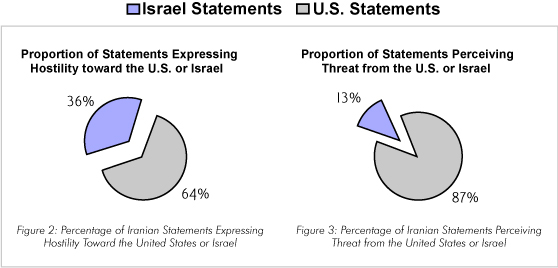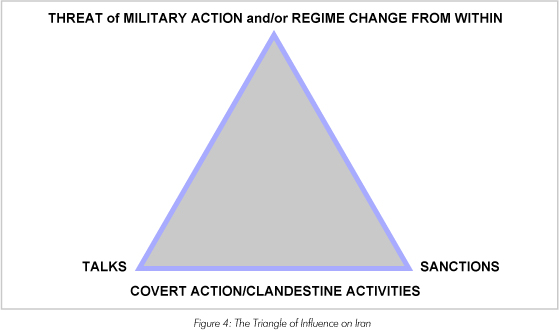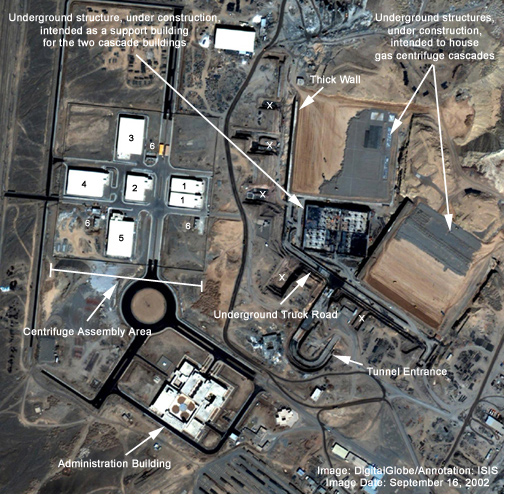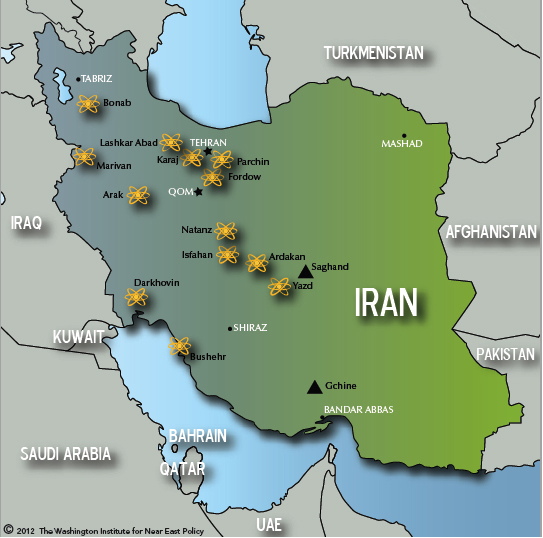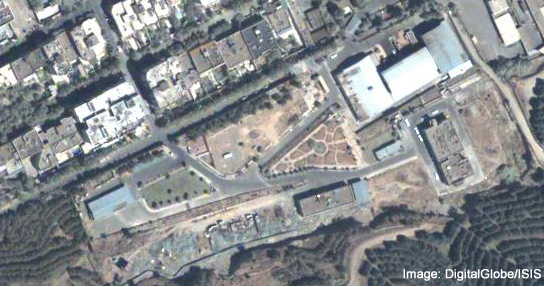Professor Raymond Tanter
Paper Presented to the International Institute for Counter-Terrorism (ICT)
Twelfth World Summit on Counter-Terrorism, Herzliya, Israel 10-13 September 2012
Paper Delivered to DACOR (formerly Diplomats and Consular Officers Retired)
An Organization of Foreign Affairs Professionals
Bacon House Foundation Annual Conference, 28 September 2012, Washington DC
Scenarios for the World Order in the 21st Century
Panel on Authoritarianism & the End of the First Nuclear Era:
The Cases of Pakistan, Iran, & North Korea
CLICK HERE FOR ARTICLE ON THE INTERNATIONAL INSTITUTE FOR COUNTER-TERRORISM WEBSITE
Introduction
In discussing how to delay or prevent a nuclear-armed Iran, consider the political system of the Iranian regime and its proliferation activities. The main argument is that because of the central role of ideology in the authoritarian nature of the Islamic Republic of Iran, traditional means of influence based on national interests have little prospect of success. Hence, there needs to be increased attention paid to bringing about regime change from within to avoid a choice between bombing Iran or living with a nuclear-armed Iran.
Given the revolutionary religious ideology of an authoritarian Iran, it is instructive to compare it with other states that have little or no freedom but have achieved nuclear weapons status, such as Pakistan and North Korea. Neither Islamabad nor Pyongyang is religion the ideology of the state. Although the official name of Pakistan is the Islamic Republic of Pakistan and religion plays an increasing role in its culture and domestic politics, religion is not as dominant in Islamabad as in Tehran. As a result, it is more likely that Pakistan and North Korea would be subject to bargaining about national interest than Iran.
Freedom in the World 2012, published by Freedom House, applies one of three broad designations to states and territories: Free; Partly Free; and Not Free, based largely on respect for political rights and civil liberties. Pakistan is in the group of Partly Free, trending toward less freedom because of blasphemy laws and an increase in official attempts to censor internet-based content. Iran is in the Not Free category, trending toward even less freedom, due to imposition of stark restrictions on nongovernmental organizations and prosecution of an increasing number of civic leaders.
Of the 48 countries designated as Not Free, nine have the lowest possible rating for both political rights and civil liberties. North Korea is a one- party regime that received the dubious distinction of being in the Worst of the Worst category. Despite being in the Not Free category, Pyongyang is more capable of striking a deal based on national interest negotiations than is Tehran.
At issue is the connection among freedom, proliferation, and deterrence, other factors being equal, which they are not. Assume an early version of democratic peace theory holds; then the fewer the political rights and civil liberties within a country, the more likely the regime will be aggressive in its international relations and hence the more dangerous it would be with nuclear weapons.
But in the context of stable deterrence, e.g., during the Cold War, the nature of the political system is less relevant because of national interest calculations. If ideology trumps interest, as in the case of the Islamic Republic of Iran, however, the nature of the political system is even more important in the hands of Iranian Islamists with nuclear weapons. And if the political system is unstable, as is the case of Pakistan, nuclear arms might fall into the hands of Islamists less likely to be deterred by a nuclear-armed India.
So, Pakistan and Iran may be more dangerous than North Korea—Islamabad because of the prospects for regime change from within that allows Islamists to seize the weapons and Tehran because its ideology is more important than interests, it is less deterrable, and potential for internal regime change are slim because dissidents are so divided and not empowered by outside forces.

Raymond Tanter and
Thomas McInerney,
What Makes Tehran Tick, Iran Policy Committee, Washington DC, 2006
Figure 1 demonstrates that Iran perceives threats to pan-Islamism and the Islamic Revolution with greater intensity than threats to its national interests. These include regional hegemony in the Persian Gulf, establishment of a sphere of influence around Iran, and prevention of a renewed threat from Iraq. While ideological imperatives and national interest considerations may be pursued at the same time, assume for the moment they can be separated enough to determine their relative impact on Iranian decisionmaking. In this respect, a primary conclusion of the Iran Policy Committee (IPC) book from which Figures 1-3 derive, What Makes Tehran Tick, is that Tehran is more motivated by its Islamist ideology than by its national interests.
As one analyst states:
Iran’s leadership clings to policies derived largely from [Ayatollah] Khomeini’s ideological vision even when such policies are detrimental to the country’s other stated national interests and even when a sizable portion of the ruling elite rejects them.
In other words, Iran’s revolutionary elite reinforces the regime’s ideological nature by adopting confrontation as a modus operandi. In this respect, “The Islamic Republic is different from its revolutionary counterparts in that the ideology of its state is its religion.” To maintain the ideological character of the Islamic Republic, Khomeini ordered the execution of political prisoners during 1988, as a litmus test of fealty to revolutionary ideals.
For the first decade of clerical rule, Ayatollah Hossein-Ali Montazeri was anointed as the successor of Khomeini, founder and leader of the regime. In March 1989, however, Khomeini dismissed Montazeri because of his protest against the massacre of members of the Mujahedeen-e Khalq (MEK) and the other opponents of the clerical rule. About 30,000 political prisoners were executed in a very short period.
In view of this discussion of the domestic situation in Iran, consider how its ideology relates to Israel and the America. The regime seeks the destruction of countries, as well as the Sunni “apostate” countries in the Middle East. Consequently, there is very little about which to negotiate with Iran, and a regional realignment that isolates Tehran has a much greater chance of success on its nuclear file than an engagement strategy that seeks to negotiate national interest trade-offs. Now consider how Iran’s authoritarian and ideological nature relates to its hostility toward Israel and the United States as well as its perception of threat from them.
Islamist Ideology Trumps Interests
The Islamic Republic of Iran is a prime-time example of an authoritarian state run by ideologically-determined clerics. The Iranian regime’s desire to destroy Israel arises mainly from incompatibility of values more than perceived economic or military threats. In this regard, consider the Figures 2 and 3 above.
During 2006, an Iran Policy Committee research team of Farsi and English speakers collected over 2,400 statements for the period 1979-2005. These statements came from the Foreign Broadcast Information Service (available in microfiche and via World News Connection) and BBC Worldwide Monitoring (via Lexis-Nexis). Search parameters were “Iran and United States” and “Iran and Israel.” The team searched for three two-week periods each year surrounding specific dates: Embassy Takeover Day (4 November), Jerusalem Day (the last Friday of the Muslim holy month of Ramadan), and May Day (1 May). The team sorted the collected statements according to perception of threat and expression of hostility.
Figure 2 shows that out of a universe of Iranian expression of hostility statements, 36% (515) were directed at Israel and 64% (919) were directed at the United States. By contrast, Iran seems to perceive very little threat from Israel. The number of perception of threat statements referring to the United States remained relatively constant (938), but only 137 statements (13% of total) assessed a threat from Israel (Figure 3).
Figure 3 indicates that Iran perceives little direct threat from Israel, but Tehran nonetheless is extremely hostile toward Israel. Indeed, the number of Iranian statements reflecting perceived threat from Israel was so low that there were not enough to conduct a reliable statistical analysis of their intensity over time. The near absence from the Iranian leadership of perception of threat statements about Israel strengthens the argument that Iran’s expressed hostility toward Israel reflects ideological rhetoric rather than any genuine sense of threat emanating from Israel.
The regime’s hostility toward Israel derives its momentum from Iran’s existential engagement in an ideological two-front war: the war for leadership of the international Islamic revival and the war against the West. The fact that Tehran perceives no direct threat from Israel, however, does not mean its hostility should be discounted.
Because the unelected clerical rulers of Iran lack popular legitimacy, they claim the legitimacy of God, terming their principal opposition that rejects the ruling order, “Mohareb,” or “Enemies of God.” Velayat-e faqih, or rule by the jurisprudent, is the Islamic Republic’s ruling principle. The Faqih is an Islamic legal expert who also exerts worldly power. The Supreme Leader of Iran, Ayatollah Ali Khamenei, considers himself as the Faqih.
In addition to the Supreme Leader, unelected regime institutions include the Guardian Council, which is the most influential body; it consists of six theologians appointed by the Supreme Leader and six jurists nominated by the judiciary and approved by parliament. It has the authority to vet and ban candidates from standing for elections to parliament, presidency, and Assembly of Experts. The latter appoints the Supreme Leader, monitors his performance, and in principle, could remove him if deemed incapable of carrying out his duties.
At the summit for the 120-member Non-Aligned Movement convened in Iran on 30 August 2012, the Supreme Leader invoked the authority of the cloth to say that Tehran considers nuclear, chemical, and similar weapons “a great and unforgivable sin.” This declaration is in contrasts to the International Atomic Energy Agency (IAEA) report (also of 30 August 2012): It stated that the IAEA is unable to provide credible assurance about the absence of undeclared nuclear material and activities in Iran; therefore the Agency is not able to conclude that all nuclear material in Iran is for peaceful purposes.
Based in part on the IAEA report, the Permanent Five Members of the UN Security Council plus Germany (P5+1) proposed to the IAEA Board of Governors a 13 September 2012 Resolution on Iran; The Board passed the Resolution, which stated that Iran “continues to defy” requirements and obligations of the United Nations Security Council (UNSC) and the IAEA.
A Triangle of Influence on Iran
In view of the authoritarian nature of the Iranian regime and uncertainties about whether it is engaged in prohibited nuclear activities, one of the most pressing issues of the day is how to delay or even prevent a nuclear-armed Iran. Figure 4 contains three legs of a triangle of options to influence Iran—threats, sanctions, and negotiations. Covert action and clandestine activities conducted by intelligence services undergird the triangle.
Threat of Military action is at the apex, an option of last resort when the other legs fail; although that threat remains on the table, military action per se is not one of the current legs of the triangle because it has yet to occur.
Also at the apex is regime change from within, which is only partly under the influence of external players. In the context of American military force used to change regimes in Iraq and Afghanistan, there is little support for an externally-driven regime change strategy to delay or prevent a nuclear-armed Iran. With Tehran’s suppression of street protests after the 2009 Iranian elections, there is scant expectation that regime change from within is viable. Also, critics counter that the regime change clock ticks slower than Iran’s nuclear progress or Israel’s closing window of opportunity for a successful attack on Tehran’s uranium enrichment, detonator research, and missile sites. But unless internal regime change is on the table, its clock cannot begin to tick.
A first step toward regime change from within was to remove the U.S. terrorist tag from the main opposition organizations that reject clerical rule in Iran, the National Council of Resistance of Iran and its largest unit, the Mujahedeen-e-Khalq (MEK), which the Department of State did during September 2012.
A second step would be to persuade dissident organizations to work together for political change in Iran, despite their prior and current enmity toward each other. It is in the infamous tradition of revolutionary moments for there to be hostility among resistance groups that jockey for power as they envision regime change.
A third step is to continue applying each tool of the triangle under the assumption that together they constitute collective action short of war, yet do not preclude use of force or pursuit of a regime change at the end of the day. Such combined efforts by the international community might eventually destabilize the regime and pave the way for democratic change in Iran.
At the base of the triangle are covert action and clandestine activities conducted by intelligence services. They also collect and share invaluable intelligence on Iran’s nuclear progress, degree to which sanctions are working, and whether diplomacy is likely to persuade Iran to comply with international demands to cease enriching uranium, place a cap on level of enrichment, and remove all enriched uranium from Iranian territory; abstain from weaponization, and refrain from marrying highly enriched uranium with a trigger mechanism and missile delivery system.
Despite use of these tools of influence by the major powers, Tehran continues on a seemingly unstoppable path to become a nuclear-armed state. Although there is little publicly available evidence to indicate the Iranian regime has made a strategic decision to produce an actual nuclear weapon, it has taken preliminary steps to do so.
Intelligence underlies the triangle of influence on Iran. Without public acknowledgement, nation states like Israel and the United States benefit from nonstate, independent sources of information based on other methods of human collection, e.g., “lead intelligence,” to compare with that derived via other means. Without facilitating such collection, Jerusalem and Washington have gained insights on Iranian nuclear facilities from the NCRI and its largest unit, the MEK, which operates clandestinely within Iran to collect sensitive intelligence.
Talks
The last round of senior-level negotiations between Iran and the major powers failed in Moscow on 19 June; lower-level talks on 26 June between a senior EU envoy and Iran’s deputy nuclear negotiator to restart higher negotiations also failed.
In a meeting in Istanbul on 18 September, Saeed Jalili, Iran’s lead negotiator in talks with the major powers, called negotiations with European Union foreign policy head, Catherine Ashton, “constructive and helpful,” although the meeting did not produce any breakthroughs or even an announcement of follow-on discussions.
Despite threats of military force and additional sanctions as drivers, negotiators have deadlocked over issues like opening up Iran’s Parchin underground munitions testing facility. The Institute for Science and International Security (ISIS) reports private satellite imagery from 25 July 2012 of what appears to be sanitization and earth displacement activity at Parchin.
It appears as if Tehran is hiding evidence from International Atomic Energy Agency (IAEA) inspectors. IAEA and ISIS reports of November 2011 and August 2012, respectively, raised the issue of whether the Parchin site has been used for testing high explosives for nuclear arms. If it were true, then the regime would be cheating like it did for almost two decades until the NCRI exposed its double-dealing in a series of revelations beginning in 2002.
Sanctions
Although sanctions alone are not likely to reverse Tehran’s quest for nuclear capability or the bomb, they have been useful in creating an alignment against the Islamic Republic. Sanctions make sense, moreover, if they remove the economic base for manufacturing a nuclear weapon or are followed by military action when sanctions no longer seem to be removing that base before Iran acquires nuclear capability or weapon.
Consider the state of play for U.S. sanctions against Iran. During the first week of August, the U.S. House voted 421-6 in favor of the Iran Sanctions, Accountability and Human Rights Act of 2012 to deprive Iran of revenue from energy production and shipping, its largest export sectors. The Senate passed the bill on a voice vote, and the measure went to President Obama for signature. The legislation punishes financial institutions, insurance companies, and shippers that help Iran sell its oil and closes loopholes that permitted Tehran to evade present sanctions. Despite such sanctions, there is evidence in recent international money-transfer investigations that Chinese banks may have flouted United States sanctions against Iran.
The president had already issued an Executive Order on 30 July that expands upon sanctions in the National Defense Authorization Act to make sanctionable knowingly conducting or facilitating significant transactions with a private or public foreign financial institution or other entity for the purchase or acquisition of Iranian oil.
Covert Actions
Sanctions combined with covert actions and clandestine activities also pressure Iran. In 2009, The New York Times reported that President Obama gave the order to speed up a wave of cyberattacks against Iran one whose existence had been exposed just three years before. But, “Tehran sensed his vulnerability, resumed enriching uranium at an underground site at Natanz, one whose existence had been exposed just three years before.”
But The Washington Post correctly credited, “An exiled opposition group, the National Council of Resistance of Iran, [which] first publicly revealed the existence of Iran’s much larger uranium facility at Natanz in 2002.”
Additional aspects of covert action are attacks on Iranian nuclear scientists. Although Tehran incredibly blames Jerusalem as working with the largest unit within the NCRI, the Mujahedeen-e-Khalq (MEK), a book by two journalists, Yossi Melman and Dan Raviv, Spies Against Armageddon, more plausibly suggests the assassinations are “blue and white,” conducted by Israeli agents from start to finish. Jerusalem, however, neither confirms nor denies whether it collaborates with the MEK but benefits from the regime’s uncertainty regarding such a potential alignment. There are even unsubstantiated rumors that Jerusalem supplied intelligence to the MEK to make its 2002 revelations, among others.
Other illustrations of covert action are assaults against Iranian installations short of war. Iran’s senior atomic energy official revealed on 17 September 2012 that a month earlier there were separate explosions, which he ascribed to sabotage. They targeted power supplies leading to Iran’s two main uranium enrichment facilities, including an underground site that is the most invulnerable to bombing.
Clandestine Activities and Intelligence
Clandestine activities (passive information collection conducted in secret), aided by the Iranian opposition, would create a toxic mix to make the Iranian regime concerned that its nuclear program has been so penetrated by foreign intelligence services and dissidents that it would not be able to conduct a secret breakout without getting caught.
Israeli Prime Minister Benjamin Netanyahu warned on 16 September 2012 that Iran would have enough enriched uranium in six to seven months. He said that by mid-2013, Tehran would be 90 percent of the way toward enough enriched uranium for a bomb. It is unclear, however, whether the Netanyahu statement derives from a formal intelligence estimate by Israel’s professionals.
Israeli Defense Minister Ehud Barak had already introduced the much-debated notion of Tehran’s “immunity threshold,” a concept that begs for enhanced intelligence collection. Created by the Israel Defense Forces (IDF) Intelligence Corps, the Iranian zone of invulnerability refers to the regime’s hardening and hiding critical parts of its nuclear program in sites basically secure from external military attack.
Barak stated on CNN during April, “There is no difference in the assessment of intelligence” between Jerusalem and Washington; despite or perhaps because of such apparent consensus, there is a need for an independent source of information based on other methods of human collection, e.g., “lead intelligence” from the Iranian resistance.
But until September 2012, the NCRI and MEK were designated on the U.S. terrorist list, which the U.S. Federal judiciary increasingly saw as illegal; similarly, former Attorney General Michael Mukasey of the George W. Bush administration wrote in the Foreword to Terror Tagging of an Iranian Dissident Organization how the designation was both unwarranted and unwise. And even President Bush credited the NCRI with revelations that led to inspections of and sanctions against Iran.
The ill-advised designation diverted MEK resources from undermining the regime internally and collecting intelligence to struggling with consequences of designation. Although constrained, the resistance has still made blockbuster revelations that helped make the case for against Iran, according to an assessment by a scholar at The Washington Institute for Near East Policy.
The Center for Strategic and International Studies wrote, “The National Council of Resistance of Iran (NCRI) revelations about Iran’s secret nuclear program did prove to be the trigger point in inviting the IAEA into Tehran for inspections…” And such inspections led to negotiations between Iran and the major powers.
As discussed above, during August 2002, NCRI intelligence exposed a secret nuclear facility near the City of Natanz. An independent think tank, the Institute for Science and International Security (ISIS), confirmed the revelation, identified the site as a uranium enrichment facility, and released imagery of Natanz in December 2002.
NCRI intelligence was the source of several other critical revelations, including:
August 2002, a heavy water production facility at Arak
ISIS stated, “The existence of this facility was first revealed publicly by the Iranian opposition group, National Council of Resistance of Iran (NCRI), in August 2002. ISIS then located the site in commercial satellite imagery after a wide-area search. By United Nations Security Council resolution 1737 (2006), Iran was to suspend all work on heavy water related projects.”
A nuclear facility at Lavizan-Shian
Again working independently from the NCRI, the ISIS wrote: “This site first came to public attention in May 2003 when the Iranian opposition group, National Council for Resistance of Iran, announced…the site.”
August 2004, laser enrichment facility at the Center for Readiness and New Defense Technology (known as Lavizan 2), built with equipment removed from the Lavizan-Shian site, kept off limits to international inspectors since its revelation by the NCRI.
ISIS obtained imagery of the site located in Tehran from August 2003; it showed large buildings inside a secure perimeter. In imagery taken on March 2004, the buildings have been removed. Further clearing can be seen in imagery from May 2004. The site’s dismantlement raises serious concerns because it is the type of measure Iran might take if it were trying to defeat environmental sampling capabilities of the IAEA.
In December 2005, intelligence of National Council of Resistance of Iran (NCRI) revealed a nuclear site near the city of Qum: Tunneling activity in the mountains was initiated in 2000 to construct an underground nuclear facility; the Western allies publicly acknowledged the Qum site in September 2009.
- Left image:DigitalGlobe image of the Qum site in June 2007. Construction materials may be seen adjacent to tunnel entrances and at construction staging areas. Right image: Image from DigitalGlobe of the Qum site in January 2009. There is much more construction and excavation activity two years later.
NCRI intelligence revealed, during September 2009, two additional sites in and near Tehran, where the Iranian regime may be working on detonators for nuclear warheads, one of the points in dispute between the IAEA and Tehran and in the nuclear negotiations.
Prompted by such publicity, the Iranian regime admitted in September of that year existence of a uranium enrichment facility about 20 miles north of Qum. And by January 2012, Iran stated it had begun enrichment at the heavily fortified site—the Fordow Fuel Enrichment Plant.
One aspect of validation concerns how there has been subsequent follow-on of revelations in which the NCRI also played a role. With respect to the Fordow facility, built beneath a mountain outside Qum, the IAEA report of August 2012 focuses on Fordow and Parchin, two facilities publicly identified in NCRI intelligence revelations before they became part of the mainstream public narratives about Iran. Again working independently of the NCRI, an ISIS report of September 2004 suggested Parchin was a suspect nuclear site, which complements revelations of the NCRI a year later.
- Left image:Satellite image of Iran’s Fordow enrichment facility near the city of Qum, 27 September 2009. Right image: Image from DigitalGlobe of the same site. There is much more construction and excavation activity, 15 August 2012
Regarding the validity of Iranian resistance revelations, Dr. Frank Pabian, Senior Nonproliferation Analyst at the U.S. Los Alamos National Laboratory in New Mexico, stated, ‘They’re [the NCRI] right 90 percent of the time. That doesn’t mean they’re perfect, but 90 percent is a pretty good record.” Even if the NCRI and MEK did not have such an impressive track record, nonstate intelligence from resistance sources is at least of value as a “lead” to compare with State-derived information using other sources and methods.
From Authoritarianism toward a Free Iran
First, it was and is in the interest of both Jerusalem and Washington that the State Department removed the NCRI and the MEK from the Department’s terrorist list in September 2012, as a first step to embrace and thus empower the Iranian resistance that rejects clerical rule in Tehran and augment collection of intelligence about Iran. Now that the terror tag has been removed, collection of dissident information as lead intelligence can accelerate and complement that of western services to bolster talks and sanctions regarding Iran. Removal of the terrorist label enhances collection of intelligence because resources used by the resistance to get off the terrorist list will be available again for intelligence collection and dissemination.
Second, facilitating resettlement of Iranian members of the MEK who remain in Iraq would help energize the organization’s intelligence capacity against Iran, and the worldwide pro-Israel community has a chance to become active in such a cause via its contacts in western parliaments.
Third, because sanctions and talks are failing to change the trajectory of the Iranian regime to become a nuclear-weapons capable state, now is the time to enhance the quality of intelligence about Iran by empowering efforts of dissident organizations that reject clerical rule and have a demonstrated capacity for collecting and distributing intelligence about Iranian nuclear progress—the National Council of Resistance and Iran and its largest unit, the Mujahedeen-e-Khalq.
Finally as freedom replaces authoritarianism in Iran, whether it has nuclear weapons or not would be of less consequence than it is now. And as an ideologically-driven Iranian regime transitions to a more secular democracy, the nuclear issue would be less of a threat to global and regional international security.
————
Professor Raymond Tanter is former member of the senior staff at the U.S. National Security Council, 1981-82; former representative of the U.S. Secretary of Defense to arms control talks in Europe, 1983-84; President of the Washington-based Iran Policy Committee since 2005; and Professor Emeritus at The University of Michigan since 1999.


